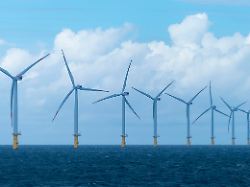Suedlink is scheduled to be completed in 2028
Ten billion north-south power line project gets underway
September 11, 2023, 6:03 p.m
Listen to article
This audio version was artificially generated. More info | send feedback
The new Suedlink route is intended to bring electricity from the north to southern Germany, which has less wind, where wind power expansion is already lagging behind. Among other things, the resistance in Bavaria has made the project significantly more expensive. And a lot of permits are still missing.
After years of delays, construction work has begun on the Suedlink direct current line near Wewelsfleht in Schleswig-Holstein. “With Suedlink, the south of Germany will be able to benefit from the large amounts of wind power from the north in the future,” explained Federal Minister of Economics Robert Habeck. The route will transport electricity from Schleswig-Holstein to Bavaria and Baden-Württemberg from 2028.
At Wewelsfleht the cables are laid under the Elbe. A walkable tunnel more than five kilometers long with an inner diameter of around four meters is planned. According to Economics Minister Habeck, the Elbe crossing is probably the most technically challenging section of the planned electricity route. The network operator Tennet is responsible for the construction.
Suedlink is intended to transport electricity south over a total distance of 700 kilometers. The route is designed for a capacity of four gigawatts, which corresponds to around ten percent of the electricity demand in Germany or the output of the three nuclear power plants that were taken off the grid in April.
“In this way, we are strengthening security of supply in Germany and also that of our neighboring countries,” explained Habeck. With the expansion of renewable energies, a significantly larger proportion of electricity is produced in wind farms in northern Germany. The existing network is already not sufficient to distribute electricity throughout Germany.
Resistance in Bavaria caused delays
Suedlink was originally scheduled to go into operation in 2022. The route was initially planned as an overland line, but there was resistance to this from the population and politicians, especially in Bavaria. The now planned underground line is significantly more expensive, with an investment sum of 10 billion euros.
So far, the authorities have approved two of the 15 sections for construction: the line under the Elbe near Wewelsfleht and a 17-kilometer-long section in the Heilbronn district. According to the Federal Network Agency, further approvals are expected to follow this year and next year. The federal government has given Suedlink an “urgent need”, and the Network Expansion Acceleration Act also eliminates one approval stage.
In July, in Leingarten, Baden-Württemberg, Federal Minister of Economics Robert Habeck and the transmission system operator TransnetBW gave the starting signal for the construction of the first of four converters for the line, which is scheduled to go into operation in 2026.
Offshore wind farms are intended to secure electricity supplies
By 2045, all electricity in Germany should come from renewable energies, with the largest share coming from offshore wind farms in the North Sea. According to the Federal Wind Energy Association, systems with a total output of a good eight gigawatts were in operation last year, and capacities are to be expanded to 70 gigawatts by 2045.
The existing network is already not sufficient to distribute electricity throughout Germany. This results in high costs: If the electricity cannot be fed in, wind turbines have to be shut down and the operators have to be compensated. In southern Germany, fossil power plants have to be started up instead.
